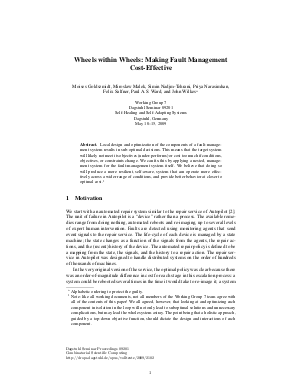Wheels within Wheels: Making Fault Management Cost-Effective
Authors Moises Goldszmidt, Miroslaw Malek, Simin Nadjm-Tehrani, Priya Narasimhan, Felix Salfner, Paul A.S. Ward, John Wilkes
-
Part of:
Volume:
Dagstuhl Seminar Proceedings, Volume 9201
Part of: Series: Dagstuhl Seminar Proceedings (DagSemProc) - License:
 Creative Commons Attribution 4.0 International license
Creative Commons Attribution 4.0 International license
- Publication Date: 2009-07-27
File

PDF
DagSemProc.09201.8.pdf
- Filesize: 128 kB
- 6 pages
Document Identifiers
Subject Classification
Keywords
- Fault management
- cost-effectiveness
Metrics
- Access Statistics
-
Total Accesses (updated on a weekly basis)
0Document
0Metadata
Abstract
Local design and optimization of the components of a fault management system results in sub-optimal decisions. This means that the target system will likely not meet its objectives (under-performs) or cost too much if conditions, objectives, or constraints change. We can fix this by applying a nested, management system for the fault-management system itself. We believe that doing so will produce a more resilient, self-aware, system that can operate more effectively across a wider range of conditions, and provide better behavior at closer to optimal cost. This document summarizes the results of the Working Group 7 - ``Cost-Effective Fault Management'' - at the Dagstuhl Seminar 09201 ``Self-Healing and Self-Adaptive Systems'' (organized by A. Andrzejak, K. Geihs, O. Shehory and J. Wilkes). The seminar was held from May 10th 2009 to May 15th 2009 in Schloss Dagstuhl~--~Leibniz Center for Informatics.
Cite As Get BibTex
Moises Goldszmidt, Miroslaw Malek, Simin Nadjm-Tehrani, Priya Narasimhan, Felix Salfner, Paul A.S. Ward, and John Wilkes. Wheels within Wheels: Making Fault Management Cost-Effective. In Self-Healing and Self-Adaptive Systems. Dagstuhl Seminar Proceedings, Volume 9201, pp. 1-6, Schloss Dagstuhl – Leibniz-Zentrum für Informatik (2009)
https://doi.org/10.4230/DagSemProc.09201.8
BibTex
@InProceedings{goldszmidt_et_al:DagSemProc.09201.8,
author = {Goldszmidt, Moises and Malek, Miroslaw and Nadjm-Tehrani, Simin and Narasimhan, Priya and Salfner, Felix and Ward, Paul A.S. and Wilkes, John},
title = {{Wheels within Wheels: Making Fault Management Cost-Effective}},
booktitle = {Self-Healing and Self-Adaptive Systems},
pages = {1--6},
series = {Dagstuhl Seminar Proceedings (DagSemProc)},
ISSN = {1862-4405},
year = {2009},
volume = {9201},
editor = {Artur Andrzejak and Kurt Geihs and Onn Shehory and John Wilkes},
publisher = {Schloss Dagstuhl -- Leibniz-Zentrum f{\"u}r Informatik},
address = {Dagstuhl, Germany},
URL = {https://drops.dagstuhl.de/entities/document/10.4230/DagSemProc.09201.8},
URN = {urn:nbn:de:0030-drops-21029},
doi = {10.4230/DagSemProc.09201.8},
annote = {Keywords: Fault management, cost-effectiveness}
}
